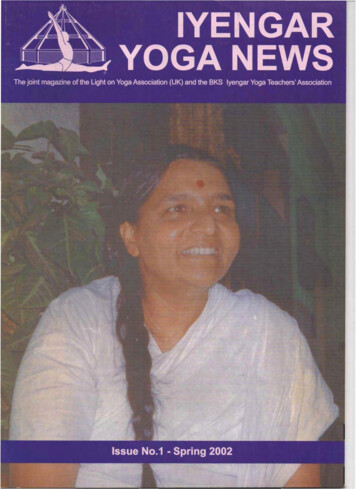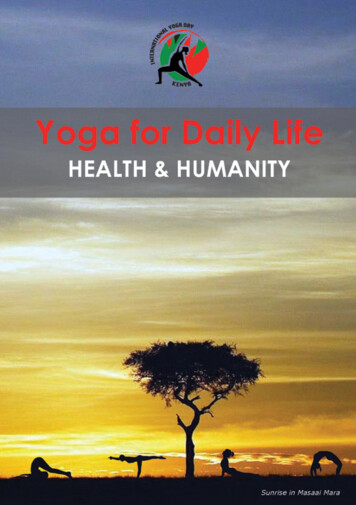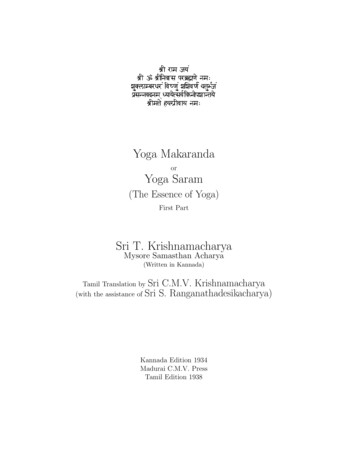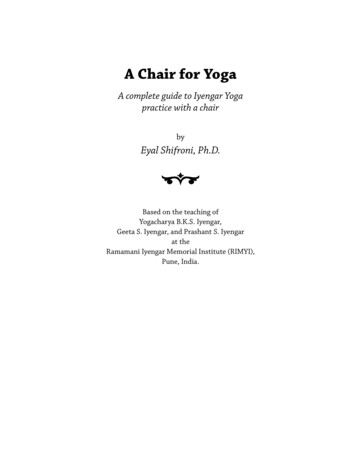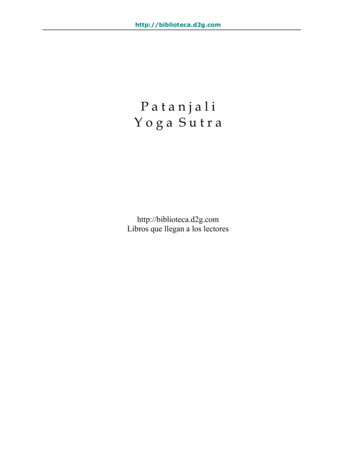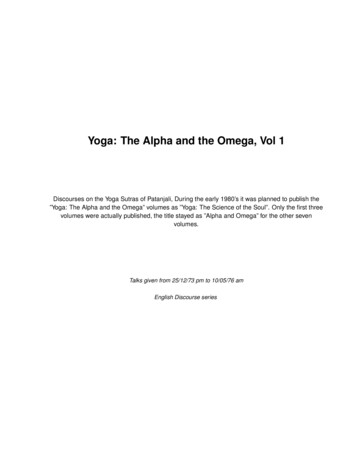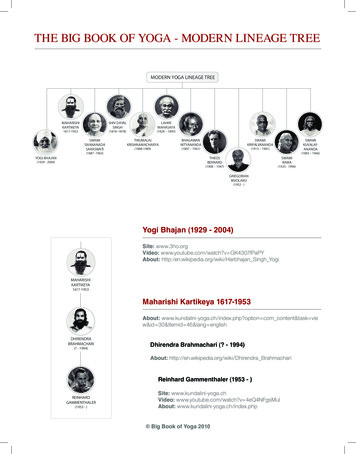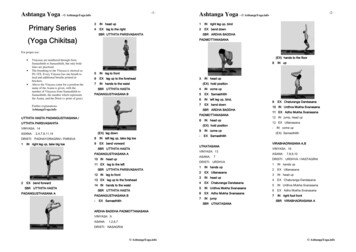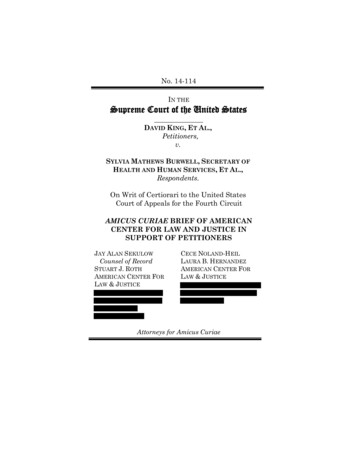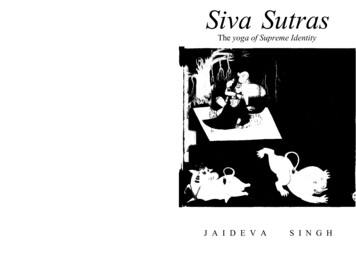
Transcription
Siva SutrasThe yoga of Supreme IdentityJ A I D E V AS I N G H
By the same author:SPANDA-KARIKAST h e Divine Creative P u l s a t i o nThis work elaborates the dynamic side of consciousness andserves as a c o m m e n t a r y on the Siva Sutras. According toSaivagama, the Divine Consciousness is not simply cold, inertintellection. It is rather spanda, active, dynamic, throbbingwith life, creative pulsation.PRATYABHIJNAHRDAYAMT h e Secret o f Self-recognitionThis work is a digest of the Pratyabhijna system of KashmirSaiva p h i l o s o p h y p r e p a r e d by K s e m a r a j a , a v o i d i n g allpolemics. Pratyabhijna means recognition. Jiva is Siva; byidentifying himself with his body, Jiva has forgotten his realnature. This teaching is meant to enable Jiva to recognise hisown real self, i.e. Siva and to attain 'at-one-ment' with SIVA.VIJNANABHAIRAVAORDivine ConsciousnessA classical treatise of yoga practices and philosophy accordingto the Kashmir tradition of Saivism. Vijnanabhairava is a verya n c i e n t book on Yoga. It studiously eschews mechanicalworship, external rites and ceremonies a n d goes directly tothe heart of the problem of the union of h u m a nconsciousness with the Divine. It describes 112 types of yoga.For this purpose, it makes full use of all the aspects of h u m a nlife - prana, manas, imagination and intuition.MOTILAL BANARSIDASSP U B L I S H E R S P V T . LTD.Delhi (INDIA)E-mail: mlbd@vsnl.comWebsite: www.mlbd.comRs. 350Code: 04066
Siva Sutras are considered to be a revealedbook of the Y o g a : supreme identity ofthe individual self with the Divine.Dr. Jaideva Singh has studied the bookwith the help of his guru Swami LaksmanaJ o o , the sole surviving exponent of thissystem in Kashmir and has provided anEnglish translation of the Sutras togetherwith the commentary of Ksemaraja.T h e subject m a t t e r is a r r a n g e d asunder:Each Sutra is given in Devanagari aswell as in Roman Script. Then the meaning of every word of the Sutra is given inEnglish, followed by a translation of thewhole Sutra. T h i s is followed by t h eVimarsini Commentary in Sanskrit andits English translation, copious notes oni m p o r t a n t a n d technical words a n d arunning exposition of the main ideas ofthe Sutra.A long introduction, together with anabstract of each Sutra, throws a flood oflight on the entire system of Saiva Yoga.A glossary of technical terms and indexare a p p e n d e d for the convenience of thereader.
Jaideva Singh (1893-1986) was a great scholarin musicology, philosophy and Sanskrit. Aformer principal of YD. College, LakhimpurKheri, he served as Chief Producer in AllIndia Radio and among other posts actedas Chairman of U.P. Sangit Natak Academi.He was awarded Padma Bhushan by theGovernment of I n d i a in 1974. After hisr e t i r e m e n t he settled in Varanasi tostudy with M.M. Gopinath Kaviraj. He dedicated the later part of his life to the studywith Kashmir Saivism. He published several books in Hindi a n d English translations of Kashmir Saiva texts, such as SivaSutras, Spanda-Karika, Pratyabhijnahrdayam,Vijnanabhairava.Select ReviewsT h e Siva Sutras a r e p e r h a p s the mostauthoritative text of Kashmir Saivism andcertainly it is an outstanding treatise on adefinite system of philosophy.The experience of Sadasiva is 'I am this'and that of Iswara is 'This am I' andSadvidya or Suddhavidya Tattva, where 'I'and 'This' side of experience are equallybalanced. It is pertinendy pointed out thatthis philosophy is unique in merging thesadhaka to a state of bliss (ananda) completely into the non-dualistic Siva.K S . Ramakrishna RaoThe Hindu (Madras), 3 July 1979Siva Sutra Vimarsini is an important treatise of Saivism. The Sutras reveal the Yogaof supreme Identity of the individual selfwith the Divine.The translater has done singular service by making the treatise accessible tothose who are interested in the subject.Assam Tribune
Siva SutrasThe Yoga of Supreme IdentityText of the Sutras and the Commentary Vimarsini of KsemarajaTranslated into English with Introduction,Notes, Running Exposition, Glossary and IndexbyJAIDEVA SINGHMOTILAL BANARSIDASS PUBLISHERSPRIVATE LIMITED DELHI
998,2000,2003,2006First Edition: Delhi, 1979 MOTILAL BANARSIDASS PUBLISHERS PRIVATE LIMITEDAll Rights Reserved,ISBN: 81-208-0406-6 (Cloth)ISBN: 81-208-0407-4 (Paper)M O T I L A L BANARSIDASS41 U.A, Bungalow Road, Jawahar Nagar, Delhi 110 0078 Mahalaxmi Chamber, 22 Bhulabhai Desai Road, Mumbai 400 026236, 9th Main III Block, Jayanagar, Bangalore 560 011203 Royapettah High Road, Mylapore, Chennai 600 004Sanas Plaza, 1302 Baji Rao Road, Pune 411 0028 Camac Street, Kolkata 700 017Ashok Rajpath, Patna 800 004Chowk, Varanasi 221 001Printed in IndiaBYJAINENDRA PRAKASH JAIN AT SHRI JAINENDRA PRESS,A-45 NARAJNA, PHASE-I, NEWDELHI 110 028AND PUBLISHED BYNARENDRA PRAKASH JAIN FORMOTILAI. BANARSIDASS PUBLISHERS PRIVATE LIMITED,BUNGALOW ROAD, DELHI 110 007
DEDICATEDwith profound respectstoMM. Dr. Gopinath Kavirajwho was a source of inspiration in lifeAnd remains a Beacon-light in death.
BLESSINGThe SIVASUTRAM is a highly respected treatise of KashmirSaivism. It contains the highest truth as expounded by LordSiva. One can attain the truth by just understanding the meaning of the sutras. Sri Jaideva Singh has done a great service toseekers by translating Sivasutra Vimarsinl into English. Nowthis great work will be available to people outside India too.May its truth spread in the world.SWAMI MUKTANANDA
Sadguru Swami Muktananda
PREFACEA year before his death, my revered Guru MM. GopinathKaviraja called me and said, "Recently one translation ofSiva-Sutras into Hindi and another into English have beenbrought to my notice. I have been both pained and shockedby the flagrant errors committed by these translators. It ismy earnest wish that you prepare another translation of thisgreat book into English."My Guru's wish was more than a command to me. I lookedinto the translations referred to. A new interpretation shouldalways be welcome, but when it goes against the very spirit andtradition of the system, it becomes a pernicious procedure. Tocite one instance, the 5th sutra of the first section is worded as'udyamo Bhairavah'. The word udyama has been translatedas 'exertion'. The first section deals with Sambliava-upaya,Even the veriest tyro of Saivagarna knows that Sambhavaupaya has nothing to do with exertion, and so 'udyama' doesnot and cannot mean exertion in this context. Even the structure and grammar of the Sanskrit language have been twistedand tortured to yield certain pre-conceived meanings. Suchpreposterous translation is, to say the least, a literary crime.I had made a promise to carry out the commands of myGuru, but when I tried to understand the text, I found myselfat sea. I was afraid of setting pen to paper lest I should doinjustice to this great scripture. Kaviraja ji was too ill to teach.So I studied the text word by word with the help of AcaryaRameshvara Jha who is a great Sanskrit scholar and fullyconversant with Saivagarna. I am very grateful to him for hishelp. I felt, however, that I should study it further with thehelp of one who has been brought up in the Saivagarna tradition.So I approached my old Guru, Svami Laksrnana Joo of Kashmirwho, in spite of his old age and a heavy schedule of engagementswith a number of scholars who had gathered round him, kindlyagreed to help. He taught me the sutras together with thecommentary of Ksemaraja and gave luminous exposition of
(viii)some very knotty problems, I am deeply beholden to him forunravelling the meaning of this difficult text.Ksemaraja, in the introductory portion of his commentary,says that since many incongruous expositions had been givenby the commentaries extant in his time, he undertook to writea new commentary in due conformity with the old tradition.I have, therefore, translated the sutras along with the Vimarsinicommentary of Ksemaraja. The style of Ksemaraja is somewhat involved, and so it has been an uphill task to translate hiscommentary into English. I have tried my best to make thetranslation as clear and readable as possible.Four commentaries on Siva-sutras are available at present,the Vimarsinl commentary of Ksemaraja in prose, the Sivasutra-vrtti by some anonymous author in prose, the Siva-sutravarttikam by Bhaskara in verse, and the Siva-sutra-varttikam byVaradaraja in verse.The Siva-sutra-vrtti is so close to Vimarsinl that it appears tobe either a preliminary draft or a later abstract of the Vimarsinl.There is a strong presumption that the author of the Vrtti wasKsemaraja himself. The Varttikam by Varadaraja is only arehash of the Vimarsinl in Verse. The Varttikam by Bhaskarais an independent commentary. He differs at places fromKsemaraja. I have indicated this in my notes or expositionwherever necessary. Ksemaraja's commentary is so detailedand scholarly that it has practically elbowed every other commentary out of existence. I have, therefore, duly followed Ksemarajain my exposition.I have adopted the following plan in the book. Each sutrais given both in Devanagari and Roman script. Then themeaning of every word of the sutra is given in English followedby a translation of the whole sutra. This is followed by theVimarsini commentary in Sanskrit. The commentary is then,translated into English. After this, copious notes are addedon important and technical words. Finally, I have given arunning exposition of the main ideas of the sutra in my ownwords.A long Introduction has been given in the beginning. Thisis followed by an abstract of each sutra. At the end of the book,
(ix)a glossary of all the technical terms and Index have beenappended.For me, this work has been a labour of love, without anyfinancial and secretarial assistance whatsoever. My great Guru,MM. Gopinath Kaviraja passed away before the work couldbe completed. I can now only console myself by dedicating itto his revered memory.Varanasi.1-1-1979JAIDEVA SINGH
TABLE OF The Main Sources of the Non-dualistic SaivaSystem of Philosophy and Yoga.The Philosophical Background of the Siva-SutrasUltimate Reality.Manifestation.Bondage.Liberation.Upayas for Liberation(i) Sambhavopaya.(ii) Saktopaya.(iii) Anavopaya.Summary of Contents of the SutrasI Section-Sambhavopaya.II Section-Saktopaya.III iiilxlxiiSIVA-SUTRAS - TEXT AND COMMENTARY.Ksemaraja's Introduction to the Sutras.1-5SECTION i - SAMBHAVOPAYA.Sutra 1 together with the Vimarsini Commentary.Sutra 2""Sutra 3""Sutra 4""Sutra 5""Sutra 6""Sutra7""Sutra 89 & 10""Sutra 11""Sutra 12""Sutra 13""Sutra -5253-5656-58
(SutraSutraSutraSutraSutraSutraSutraSutraxii)15 together with the Vimarsini 3-6565-6868-7272-7575-7777-81SECTION II utraSutra1 together with the Vimarsini utraSutraSutraSutraSutraSutraSutra1 together with the Vimarsini "14""15""16""17""SECTION III 160-161161-162162-165165-168
(xiii)Sutra 18 together with the Vimarsini Commentary.Sutra 19""Sutra 20""Sutra 2!""Sutra 22""Sutra 23""Sutra 24""Sutra 25""Sutra 26""Sutra 27""Sutra 28""Sutra 29""Sutra 30""Sutra 31""Sutra 32""Sutra 33""Sutra 34""Sutra 35"''Sutra 36""Sutra 37""Sutra 38""Sutra 39""Sutra 40""Sutra 41""Sutra 42""Sutra 43""Sutra 44""Sutra 45""Conclusion.Glossary of Technical Terms.Subject Index.Index to important Sanskrit Words.Alphabetical Index to the 230231-234235-263265-266267-275276-278
INTRODUCTIONTHE MAIN SOURCES OF THE NON-DUALISTIC SAIVASYSTEM OF PHILOSOPHY AND YOGAThe Saiva system of Philosophy and Yoga is generally knownas Agama. The word Agama means a traditional doctrine orsystem which commands faith.The Saiva system,, in general, is known as Siva-sasana orSivagama, The non-dualistic Saiva system of Kashmir is knownas Trika-Sasana or Trika-sastra or Rahasya-sarnpradaya. Thewords sasana and sastra are very significant. Both containthe root sasa which means discipline. Sasana or Sastra meansteaching containing rules for discipline. A Sastra or Sasana inIndia never meant merely an intellectual exposition of a particularsystem. It certainly expounded the fundamental principles ofreality but at the same time laid down on the basis of t h e principlescertain rules, certain norms of conduct which had to be observedby those who studied the particular Sastra. A Sastra was notsimply a way of thought but also a way of life. The Saivaphilosophy of Kashmir is generally called 'Trika Sastra, becauseit is philosophy of the triad - (1) Siva (2) Sakti (3) Nara the bound soul or (1) para - the highest (2) parapara - identityin difference and (3) apara - difference.The literature of the Trika system of Kashmir falls into threecategories, viz., (1) the Agama Sastra, (2) the Spanda .Sastra and(3) the Pratyabhijna Sastra.AgamaSastra:Agama Sastra is considered to be revelation by Siva. Itlays down both the principles and practices of t h e system.Among the works belonging to the Agama category may bementioned the following Tantras.Malinivijaya or Malinivijayottara, Svacchanda, VijnanaBhairava, Mrgendra, Netra, Rudra-Yamala, Siva-Sutras, etc.Most of these taught generally the dualistic doctrine. Themost important Agama of the Trika system was k n o w n as theSiva-Sutras.
(xvi )Siva-Sutras:The importance of this work consists in the fact that it wasrevealed to counter the effects of dualism.1 It is generally knownas Sivopanisat-sangraha - a compendium containing the secretdoctrine revealed by Siva. This was revealed to Vasugupta.There are three theories regarding the revelation of the SivaSntras to Vasugupta.1. Kallata in the Spanda-vrtti says that Siva taught the SivaSntras in a dream to Vasugupta who was living on Mahadevamountain in the valley of the Harvan stream behind the Shalimargarden near Srinagara.2. Bhaskara says in his Varttika on the Siva-Sutras thatthey were revealed to Vasugupta in a dream by a Siddha - aperfected semi-divine being.3. Ksemaraja, in his commentary Vimarsini, maintainsthat Siva appeared to Vasugupta in a dream and said, "On theMahadeva mountain, the secret doctrines are inscribed on apiece of stone. Collecting the doctrines from there, teachthem to those who deserve grace." On waking up, Vasuguptawent to the place and by a mere touch the particular stone turnedup and he found the Siva-Sutras inscribed on it.The particular rock is still called Samkaropala, and it is saidthat the Sutras were inscribed on it. (See the plate No. 1). Therock is there, but there is no trace of the sutras.The following are the common points in all the theoriesregarding the discovery of the Siva-Sutras.1. There was no human author of the Sutras. They originated from Siva.2. They were revealed to Vasugupta.Whether they were revealed to him by Siva in a dream or bya Siddha or they were found on a rock at the instance of Sivaare matters which are irrelevant to the main issue of the revelation.S.S.V.P.5.
xviiDate of the Discovery of the Sutras:We know from Rajatarangini that Kallata flourished in thereign of king Avanti-Varman of Kashmir,Avanti-Varmanreigned in the 9th Century A.D. Vasugupta who had discoveredthe Siva-Sutras was the guru (teacher) of Kallata. He musthave flourished either in the last part of the 8th Century or thebeginning of the 9th Century A.D. This must have beentherefore, the date of the discovery of the Sutras.Commentaries on the Siva-Sutras:Ksemaraja says in his commentary Vimarsini that he noticeddiscrepancies in the various commentaries prevalent in his time.Therefore, he undertook to write a new commentary. He hasnot named the commentaries in which he noticed discrepancies.Only four commentaries have survived.1. The Vrtti.2. The Varttika by Bhaskara.3. The Vimarsini by Ksemaraja.4. The Siva-Sutra-varttikam by Varadaraja alias Krsnadasa.The author of the Vrtti is not known. The commentaryvrtti tallies with Vimarsini not only in interpretation but alsomostly in words. It appears that either the Vrtti was written atfirst and was used by Ksemaraja as a framework for elaborationor that Vimarsini was written at first and either Ksemarajahimself or some one else prepared an abstract of it in the Vrtti.Bhaskara says in the introductory portion of his Varttikathat Vasugupta taught the Siva-Sutras to Kallata who taughtthem to Pradyumnabhatta, the son of his maternal uncle.Pradyumnabhatta taught them to his son Prajnarjuna. Prajnarjuna taught them to a pupil, Mahadevabhatta who in turntaught them to his son, Srikanthabhatta. Bhaskara himselflearned the sutras from Srikanthabhatta. Bhaskara flourishedin the 11th century A.D. So his Varttika was written duringthat period.The Vrtti gives the main ideas of the Sutras in a very succinctform in prose. Bhaskara in his Varttika interprets each sutrain verse.The Vimarsini commentary of Ksemaraja gives a lucid anddetailed exposition of each sutra in prose. He substantiates his
xviiiinterpretation by giving parallel and valuable quotations fromother books some of which are now completely lost to us.It is well-known that Ksemaraja was a pupil of Abhinavaguptawho flourished in the 10th Century. The Vimarsini Commentary must have been written by Ksemaraja in the 10th Century.Ksemaraja was a prolific writer. He wrote the following w o r k s :Pratyabhijnahrdayam, Spandasandoha, Spandanirnaya, Svacchandoddyota, Netroddyota,Vijnanabhairavoddyota, Sivasutra-vimarsini, Stavacintamanitika, Parapravesika, Tattvasandoha, Utpala's Stotravalitika.The fourth commentary on the Siva-Sutras is the Siva-Sutravarttikam by Varadaraja alias Krsnadasa. The Varttika ofVaradaraja is only a rehash of the Vimarsini in Verse. Varadaraja has no interpretation of his own to give. He lived towardsthe end of the 15th Century A.D.Of all the commentaries that have survived, Vimarsini byKsemaraja is the oldest and the most learned.2.Spanda SastraThis elaborates the principles laid down in the Siva-Sutras.It works out the details of the Siva-Sutras mainly from the pointof view of Sakti.The main work of this Sastra is the Spanda-sutras or SpandaKarika as generally known. On this, there are the followingcommentaries:Pradipa by Utpala Vaisnava, Vivrti by Ramakantha, Spandasandoha and Spandanirnaya by Ksemaraja. Spandasandohacontains a commentary only on the first Karika.Ksemaraja thinks that the Spanda-Sutras were written byVasugupta. Others maintain that they were written by Kallata,the pupil of Vasugupta.3.The Pratyabhijha Sastra:This contains the philosophy proper of the system. It expounds the Trika philosophy by arguments and discussions.The first philosophical work was Siva-drsti composed bySomananda. He was the pupil of Vasugupta. He flourishedin the 9th Century A.D. Siva-drsti is a very important philosophical work. Unfortunately the full text is not yet available.
xixSomananda composed a vrtti on Siva-drsti, but it has not beentraced as yet.The most important available work of this Sastra is thePratyabhijna-sutras or Isvara-pratyabhijna by Utpala who was apupil of Somananda. The Pratyabhijna-sutras acquired somuch importance that the whole philosophy of Kashmir isgenerally known as Pratyabhijna-darsana. There are the following commentaries on the Pratyabhijna-sutras.1. The Vrtti by Utpala himself available only in an incompleteform.2. The Pratyabhijnavimarsini by Abhinavagupta.3. The Pratyabhijna-vivrti-vimarsiniby Abhinavagupta.This is a commentary on the lost tika known as Vivrti by Utpalahimself.Besides the above, there is the great work known as Tantralokaby Abhinavagupta. It is in 12 volumes and contains the Saivaphilosophy and practice in all their aspects. There is also thedigest of the twelve volumes known as Tantrasara. Jayarathahas written the commentary Viveka on Tantraloka.The Philosophical Background of the Siva-Sutras:Siva-sutras are a treatise on Yoga, but this Yoga is based ona definite system of Philosophy. It will not be possible tounderstand this yoga unless there is a clear grasp of the philosophy on which it is based.We may consider the philosophical background of this Yogaunder the following h e a d s : 1. Ultimate Reality. 2. Manifestation or the world-process. 3. Bondage. 4. Liberation.1.Ultimate Reality:Ultimate Reality is cit or Parasamvit. It is non-relationalconsciousness. It is the changeless principle of all changes.In it, there is no distinction of subject and object, of I and This.It is the Supreme Self surveying Itself. In the words of Pratyabhijna Sastra, it is prakasa-vimarsamaya. Prakasa is the EternalLight without which nothing can appear. It is Siva. Vimarsais Sakti, the svabhava of Siva. It is, so to speak, the mirror inwhich Siva realizes His own grandeur, power and beauty.Vimarsa is the Kartrtva Sakti (the power of doership) of Siva.
XXMere Prakasa cannot be the nature of Reality. Even diamondis prakasa, but the diamond does not know itself as prakasa.Vimarsa is that aspect of prakasa by which it knows itself. Thatself-knowledge is an activity.Vimarsa betokens that activity. As Ksemaraja says in hisParapravesika (p. 2), Vimarsa is "akrtrimaham iti visphuranarn."It is the non-relational, immediate awareness of I. Ksemarajarightly says, "Yadi nirvimarsah syat anisvaro jadasca prasajyeta"(Parapravesika, p. 2) i.e. "If Ultimate Reality were merelyprakasa and not also vimarsa, it would be entirely powerlessand inert." It is this I-consciousness of Ultimate Reality thatis responsible for the manifestation, maintenance, and reabsorption of the universe.Cit is conscious of itself as Cidrupini sakti. This consciousness of itself as Cidrupini sakti is Vimarsa. Vimarsa has beennamed variously as parasakti, svatantrya, aisvarya, Kartrtva,sphuratta, sara, hrdaya, spanda. (Parapravesika, p. 2).It is because Sankara Vedanta considers Brahman to be onlyprakasa or jnana (light or illumination) without any vimarsa oractivity that it has to invoke the help of Maya for the manifestation of the universe. Brahman is devoid of any activity; it is,therefore, impotent to create. It is, only Isvara or mayopahitacaitanya that can manifest the universe. But whence does thisMaya drop i n ? If it is some power extraneous to Brahman orIsvara, then Sankara Vedanta is reduced to dualism. If Mayais only an expression of the power of Brahman, then Brahmancannot be divested of activity. Both Sankhya and Vedantaconsider the Purusa or Atma to be niskriya or inactive, becausethey take the word 'activity' in a very crude sense. Surely,Brahman or Atma does not work like a potter or watch-maker.The very Vimarsa, the very Iccha (will) of the Divine is spiritualenergy of incalculable force that can proliferate into any formfrom the subtlest to the grossest.Svatantrya or unimpeded Sovereignty is the characteristicpar excellence of Siva. It expresses itself into Ichha (will) whichimmediately translates itself into jnana (knowledge) and kriya(action).Ultimate Reality is not only Universal Consciousness butalso Supreme spiritual energy or Power. This All-inclusive
xxiUniversal Consciousness is also called Anuttara, the HighestReality, the Absolute. It is both transcendental (visvottirna)and immanent (visvamaya).2.Manifestation or the World Process:It is the svabhava or very nature of Ultimate Reality to manifest. Creativity is of the very essence of Divinity. If UltimateReality did not manifest, it would not be Self or consciousness,but not-Self, something like a jar.As Abhinavagupta puts i t :Tantraloka, III, 100."If the Highest Reality did not manifest in infinite variety,but remained cooped up within its solid, singleness, it wouldneither be the Highest Power nor Consciousness, but somethinglike a jar."Ultimate Reality or Parama Siva is prakasavimarsamaya. Inthat state, the 'I' and the 'This' are in an undivided unity. The 'I'is the prakasa aspect. 'This' or its consciousness of itself is thevimarsa aspect. This Vimarsa is svatantrya or unimpededsovereign power or Sakti. This Vimarsa is not contentless.It contains all that is to be.Paratnmsika, 34."As the great banyan tree lies only in the form of potency inthe seed, even so the entire universe with all the mobile andimmobile beings lies as a potency in the heart of the Supreme."The Sakti of the Supreme is called Citi or parasakti or paravak.We shall see in the sequel what part parasakti or paravak playsin the manifestation of word and its object.Parama Siva has infinite powers, but the following may beconsidered to be the main o n e s :1. Cit - the power of Self-revelation, the changeless principle of all changes. In this aspect, the Supreme is known asSiva.
xxii2. Ananda or Absolute bliss. This is also called svatantrya,In this aspect, the Supreme is known as Sakti. Cit and anandaare the very svarupa or nature of Pararna Siva. The rest may beconsidered to be His Saktis.3. Iccha or Will. In this aspect, He is known as Sadasiva orSadakhya.4. Jnana or knowledge. In this aspect, He is known as Isvara.5. Kriya - the power of assuming any and every form. Inthis aspect, He is known as Sadvidya or Suddha Vidya.The Universe is simply an opening out (unmesa) or expansion(prasara) of the Supreme as Sakti.The following appear in the course of manifestation.I. THE TATTVAS OF THE UNIVERSAL EXPERIENCE 1-5As has already been said Parama Siva has two aspects, viz.,transcendental (visvottirna) and immanent or creative. Thiscreative aspect of Parama Siva is known as Siva tattva.1. Siva tattva is the initial creative movement (prathamaspanda) of Parama Siva.2. Sakti tattva is the Energy of Siva. She polarizes Consciousness into Aham and ldam (I and This) - Subject andobject.Sakti, however, is nothing separate from Siva. Siva in hiscreative aspect is known as Sakti. She is His ahamvimarsa(I-consciousness), His unmukhata or intentness to create.Just as an artist cannot contain his delight within himself, butpours it out into a song, or a poem, even so Parama Siva poursout the delightful wonder of His splendour into manifestation.In .Sakti tattva, ananda aspect of the Supreme is predominant.Siva and .Sakti tattvas can never be separated.3.Sadasiva or Sadakhya Tattva:The will (Iccha) to affirm the 'This' side of the UniversalExperience is known as sadasiva or Sadakhya tattva. In Sadasiva,Iccha (Will) is predominant.The experience of this stage is 'I am this', but the 'this' is onlya hazy (asphuta) experience. The predominant side is still 'I'.The Ideal Universe is experienced as an indistinct something inthe depth of consciousness.
xxiiiSadasiva tattva is the first manifestation (abhasa). In this Universal Experience, both the subject and object are consciousness.Consciousness in this aspect becomes perceptible to Itself; hencea subject and an object.4.Isvara or Aisvarya TattvaThe next stage of the Divine experience is that where Idam orthe This side of the total experience becomes a little more defined(sphuta). This is known as Isvara tattva. It is unmesa or distinct blossoming of the Universe. At this stage, jnana orknowledge is predominant.The experience of Sadasiva is 'I am this'. The experience ofIsvara i s : 'This am I.'5.Sadvidya or Suddhavidya Tattva:In the Sadvidya tattva, the 'I' and the 'This' side of experienceare equally balanced like the two pans of an evenly held balance(samadhrtatulaputanyayena). At this stage, kriya sakti is predominant. The 'I' and 'This' are recognized in this state withsuch equal clarity that while both 'I' and 'This' are still identified,they can be clearly distinguished in thought. The experience ofthis stage may be called diversity-in-unity (bhedabheda-vimarsanatma) i.e. while the 'This' is clearly distinguished from 'I', itis still felt to be a part of the 'I' or Self. What is 'I' is This',what is 'This' is 'I' i.e. they have samanadhikarana.The experience of this stage is known as parapara dasa. Itis intermediate between the para or higher and apara or the lower.Upto this stage, all experience is ideal i.e. in the form of anidea. Hence it is called the perfect or pure order (Suddhddhva)i.e. a manifestation in which the svarupa or the real nature ofthe Divine is not yet veiled.II.THE TATTVAS (PRINCIPLES) OF THE LIMITEDINDIVIDUAL EXPERIENCE6-11 Maya and the Five KancukasNow begins the play of Maya tattva. From this stage onward,there is Asuddhddhva or impure order in which the higher, idealnature of the Divine is veiled. All this happens because of
xxivMaya and her kancukas, Maya is derived from the root 'ma',to measure out. That which makes experience measurable i.e.limited, and severs the 'This' from 'I' and 'I' from 'This' andexcludes things from one another is Maya.Upto Sadvidya, the experience is universal; the 'This means'all this', the total universe. Under the operation of Maya,'this' means merely 'this', different from every thing else. Fromnow on starts sahkoca or contraction, limitation. Maya drawsa veil (avarana) on the Self owing to which he forgets his realnature, and thus Maya generates a sense of difference.The products of Maya are the five Kancukas or coverings.Their functions are given below:(i) Kala. This reduces the sarvakartratva (universal authorship) of the universal Consciousness and brings about limitationin respect of authorship or efficacy.(ii) Vidya. This reduces the omniscience (sarv
this philosophy is unique in merging the sadhaka to a state of bliss (ananda) com pletely into the non-dualistic Siva. KS. Ramakrishna Rao The Hindu (Madras), 3 July 1979 Siva Sutra Vimarsini is an important trea tise of Saivism. The Sutras reveal the Yoga of

